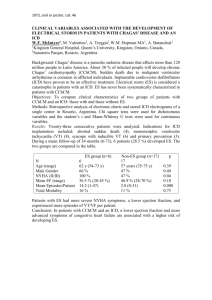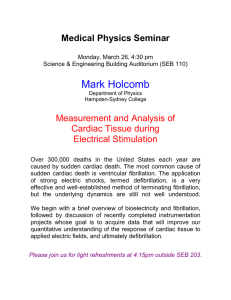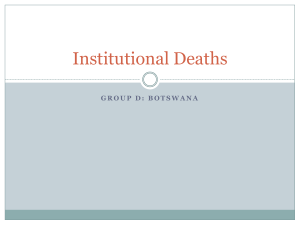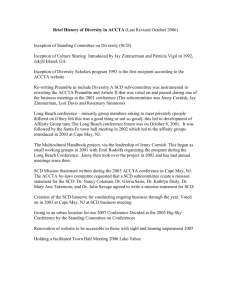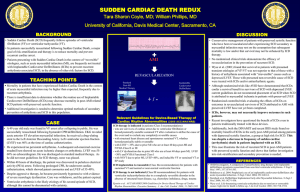AC ICD VT 8-1
advertisement
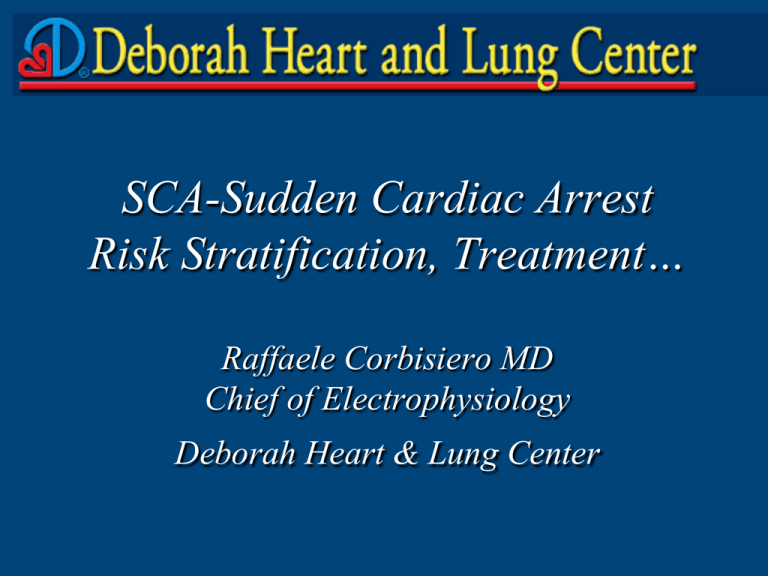
SCA-Sudden Cardiac Arrest Risk Stratification, Treatment… Raffaele Corbisiero MD Chief of Electrophysiology Deborah Heart & Lung Center SCA-Where are we? Tim Russert SCA_PSA_BROKAW_1.wmv Fibrillation Clinical Perspective Leading Causes of Death in the U.S. Septicemia Nephritis You must combine deaths from all cancers to outnumber the deaths from SCD each year. Alzheimer’s Disease Influenza/pneumonia Diabetes Accidents/injuries Chronic lower respiratory diseases Cerebrovascular disease Other cardiac causes Sudden cardiac death (SCD) All other causes All cancers 0% 5% 10% 15% 20% National Vital Statistics Report. Oct. 12, 2001;49(11). MMWR. State-specific mortality from sudden cardiac death – US 1999. Feb 15, 2002;51:123-126. 25% Magnitude v The 5 year mortality of survivors of AMI with LV dysfunction after hospital discharge is > 20% v SCD accounts for at least 33% of late mortality v Only 2 to 30% with out-of-hospital cardiac arrest survive JACC 15 April 1999 (Vol. 83, Issue 8, Pages 1280-1283) Putting it into perspective v 42,000 deaths per year from car crashes (5-6 times less annual SCD risk but we now have mandated seat belt laws not to mention the cost to all of us and to the Automobile industry for installing them and the authorities for monitoring their use) v 41,000 deaths per year from breast cancer (Mammograms are now the standard of care) v 7,000 children die from SCD each year (Cities across the US are mandating AED’s in schools) The Magnitude of the Problem 50 1 month survival, bystander witnessed Sudden Death 40 % Survival v =350,000 deaths per year v Likelihood of surviving an episode of sudden death is very low v Early shocks work v Late shocks don’t work v Shocks only work if they can be delivered in the first few seconds 30 20 10 0 0 5 10 15 Time (minutes) JACC 15 April 1999 (Vol. 83, Issue 8, Pages 1280-1283) 20 SCD Survival Rate % Personal Defibrillation 99% SCA is treated automatically without need for a second party, and treatment occurs in < 1 minute. • ICD or Wearable Defibrillator Hospital Defibrillation 18% Bystander Defibrillation < 10% NRCPR/AHA Mary Ann Peberdy MD (17,991 cardiac arrests / 250 hospitals) 18% Daytime 13% Night SCA must be witnessed, and there is generally a protracted treatment delay. SCA has a better chance of being witnessed and treatment is more readily available • EMS 911 Service • Public Access Defibrillation One man’s danger is another man’s therapy ECG (De)Fibrillation Historical Perspective ICD history 1966 Conception 1969 First experimental model 1969 First transvenous defibrillation 1975 First animal implant 1980 First human implant 1982 Addition of cardioverting capability 1985 FDA approval 1988 First programmable device implanted ICD History v Initial development pioneered in the late 1960’s by Dr. Michel Mirowski v Following the death of his Chief of Staff, Dr. Harry Heller he was driven to prevent Sudden Cardiac Death (SCD) v His dream came to reality in 1985 Secondary Prevention Primary Prevention Evolution of ICD Indications Studies Incremental Indications Preventio n Strategy Year of CMS Coverage SCD Survivors All survivors of sudden cardiac death Secondary 1991 AVID Sustained VT/VF; EF ≤ 40% with no prior cardiac arrest Secondary 1999 MADIT I MUSTT Prior MI; EF ≤ 40%, non-sustained VT, inducible VT Primary 1999 MADIT II Prior MI; EF ≤ 35%, no EP study required Primary 2003 SCD-HeFT No prior MI, EF ≤ 35%, Class II/III heart failure Primary 2005 Primary 2005 COMPANION Class IV heart failure Relative Reduction in Mortality (%) Trial Summary: Reduction in AllCause Mortality with ICDs 70% 60% 55% 54% 50% 36% 40% 31% 30% 23% 20% 10% 0% MADIT1 MUSTT2 MADIT-II3 COMPANION4 1. Moss AJ, et al. N Engl J Med. 1996;335:1933-1940. 2. Buxton AE, et al. N Engl J Med. 1999;341:1882-1890. 3. Moss AJ, et al. N Engl J Med. 2002;346:877-883. 4. Bristow MR, et al. N Engl J Med. 2004;350:2140-2150 5. Bardy, GH, et al. N Engl. J Med. 2005; 352:225-237 SCD-HeFT5 ICDs Are Cost Effective 250 Cost/$1,000 200 150 100 50 0 Dialysis Heart Tx HTN 1V CABG 3V CABG Cost/YOLS Mushlin, Circulation 1998; 2129-2135 ICD Prim Smoke Cholest Alarms Summary Primary Prevention Know your EF Just like Chol., Just like BP CAD CM +/- CAD EF 30-40% EF <35% CHF EPS +/- ICD ICD MADIT,MUST EF < 30% ICD MADIT II SCD HeFT Summary Secondary Prevention Any event not explained… VF, VT with hemodynamic compromise or symptoms AVID Therapy Issues Incidence of SCD in Specific Populations and Annual SCD Numbers GROUP General population Patients with high coronary-risk profile Risk Stratification Patients with previous coronary event Patients with EF < 35%, congestive heart failure SCD-HeFT Under-penetration Patients with previous out-of-hospital cardiac arrest AVID, CASH, CIDS Patients with previous MI, low EF and VT MADIT, MUSTT, MADIT II 0 5 10 15 20 25 Incidence of Sudden Death (% of group) Myerburg RJ. Circulation.1998;97:1514-1521. 30 0 100,000 200,000 300,000 No. of Sudden Deaths Per Year Utilization of Primary Prevention ICD’s “…the most significant takeaway from our analysis on the prevalence pool is that penetration remains relatively low.” 22-36% Source Morgan Stanley Estimates Know Your Numbers Ejection fraction Blood pressure cholesterol Do You Know YOUR Numbers ? N = 1007 563 444 NO knowledge SOME knowledge CHOL & EF 2 BP & EF BP & CHOL 142 18 CHOL only Know ALL CRF 48 Know >1 CRF BP only Know 1 CRF 190 32 EF only 162 12 250 The Numbers For the most part, all these numbers are silent killers, without symptoms or warning signs. If symptoms arise, it’s might be too late. ICD History! Not What They Look Like v Epicardial Systems ICD Implant Morbidity is low EP lab DDD PPM Pectoral ICD NTL, abdom Thoracotomy OR 0 5 10 % Complications Current Opinion in Cardiology 2001 16:66-71 15 Can we say the same for drugs… v ICD complication Rates Can we say the same for drugs… v Complication rates Pooled complication rates of chronic total occlusion percutaneous coronary interventions. CABG = coronary artery bypass graft; CN = contrast nephropathy; MACE = major adverse cardiac events; MI = myocardial infarction; QWMI = Q-wave myocardial infarction Secondary Treatment Options Secondary Treatment Options Secondary Treatment Options Secondary Treatment Options Secondary Treatment Options Secondary Treatment Options Substrate Modification-No VT needed Interventional Help…. Summary v SCA remains an under-recognized and undertreated issue… v Non pharmacologic therapy, the ICD is our most effective strategy v ICD issues… v VT ablation is a useful but secondary treatment option, substrate modification… SCD in Preserved LVEF Community-based studies of SCD v Stecker et al (2006) • 714 SCD cases in Multnomah County, OR (2002-2004) • Only one-third of the evaluated SCD cases had severe LV dysfunction meeting current criteria for prophylactic ICD implantation • “These findings support the aggressive development of alternative screening methods to enhance identification of patients at risk.” v deVreede-Swagemakers et al (1997) • 515 SCD cases in Maastricht, Netherlands (1991-1994) • 56.5% of all SCA victims had an LVEF > 30% Stecker, E.C., et al., Population-based analysis of sudden cardiac death with and without left ventricular systolic dysfunction: twoyear findings from the Oregon Sudden Unexpected Death Study. J Am Coll Cardiol, 2006. 47(6): p. 1161-6. de Vreede-Swagemakers, J.J., et al., Out-of-hospital cardiac arrest in the 1990's: a population-based study in the Maastricht area on incidence, characteristics and survival. J Am Coll Cardiol, 1997. 30(6): p. 1500-1505. Remaining Issues • Under-penetration in the current primary prevention population • Patient identification (education, resources) • Patient selection (advanced age, co-morbidities) • Reluctance • Physician: Is EF the best risk stratifier?, recalls, inappropriate shocks, optimization of pharmacologic therapy • Patient: psycho-social aspects of ICD, morbidity, recalls • Societal: cost-effectiveness, number needed to treat (NNT) • Identification of high-risk patients who do not meet current primary prevention indications ECG Electrodes • 4 Total • No adhesive & no gel LifeVest System 3100 Self-Gelling Defibrillation Electrodes Response Buttons Monitor • 1.8 lbs • 150 joules • Stores ECG, daily use, etc. LifeVest may be used as a: Bridge to ICD Outpatient, immediate, automatic, non-invasive protection against SCD, until ICD, or until no longer at risk Awaiting post MI, post revascularization, post explant period Scheduling Tool Patient overflow Discharge Planning Tool Weekends Holidays

